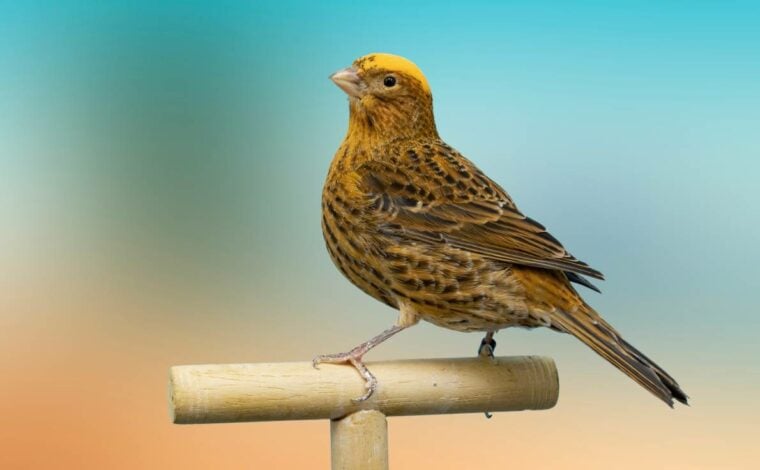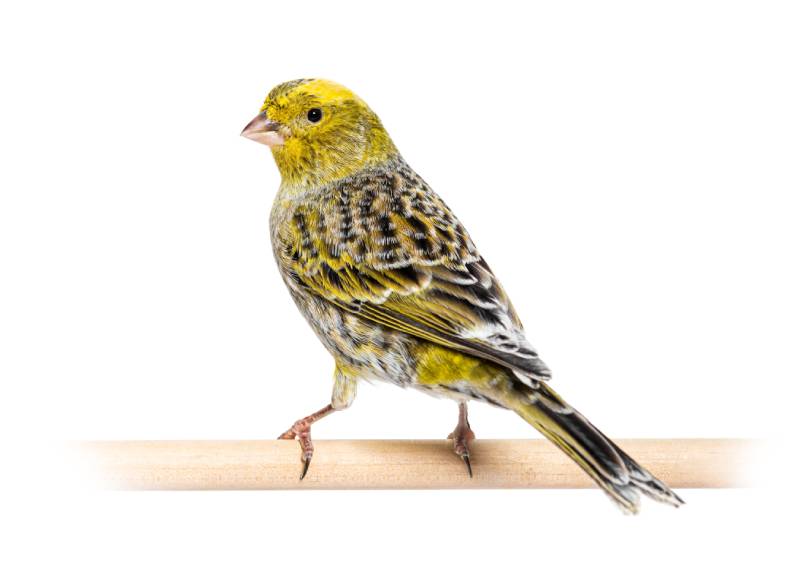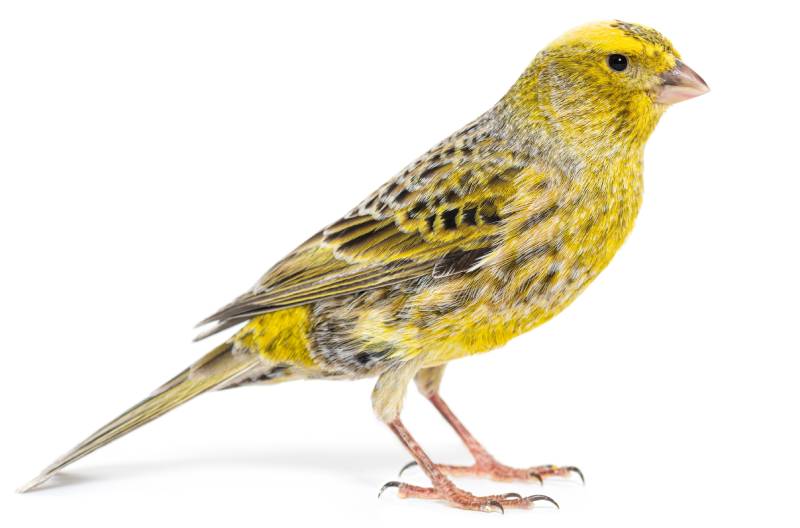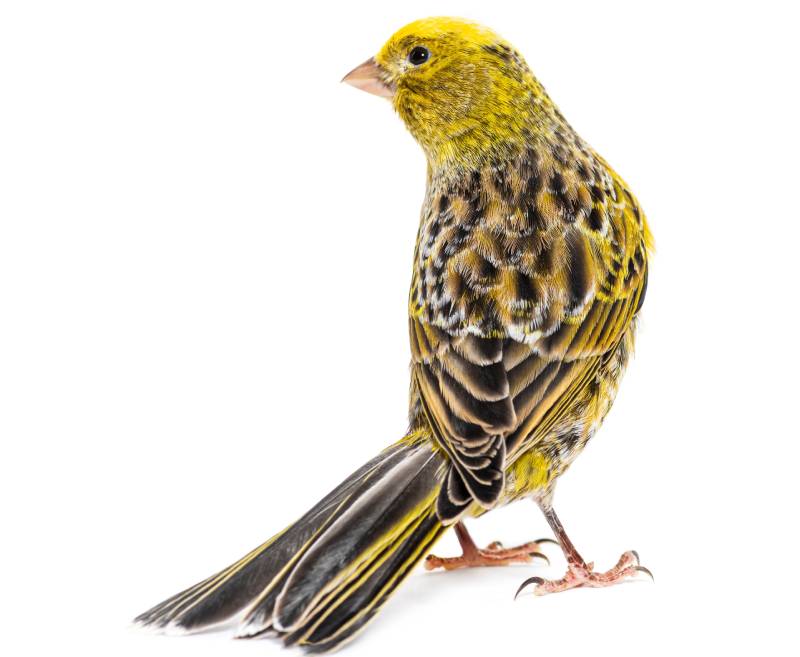
Lizard Canaries are one of the oldest canary breeds and have had an up-and-down journey since their inception in the 1700s. The breed almost became extinct throughout the early to mid-1900s. Thankfully, with the help of some very dedicated fanciers, the Lizard Canary was saved from extinction and is now one of the most popular canary breeds.
You should keep reading if you’re considering adopting one of these beautiful, speckled birds. We’ll review everything new and potential owners need to know about the Lizard Canary before they bring one home.
Species Overview

| Common Names: | Lizard Canary |
| Scientific Name: | Serinus canaria domesticus |
| Adult Size: | 5.5 inches |
| Life Expectancy: | 6–12 years |
Origin and History
The first mention of the Lizard Canary goes way back to the 1700s when it was believed to be a mutation bred in captivity throughout France. This species was bred for many years but began a slow and steady decline in the early 1900s. This decline was partly due to the wars occurring at the time, as bird breeding wasn’t a main focus. Disease epidemics were also to thank for the population decline of the Lizard Canary.
The population dwindled so much by the mid-1940s that only a few dozen breeding pairs were left. Thankfully, the Lizard Canary Association of Great Britain stepped in and helped facilitate a “come back” breeding program which is why this breed can live and thrive today.
Temperament
As with all animals, each individual canary will have its own personality. For example, you may adopt one that’s outgoing and enjoys being talked to and hanging out with its parents. Or, on the other hand, yours might be on the shy side, preferring a much quieter and less-traveled room for its cage.
Canaries can be very social little birds. While they enjoy being around humans, they don’t appreciate being held like other bird species do. As a result, they can live well in solitary and won’t get lonely if housed alone.
They are gentle birds that won’t harm your children or other pets in your home (though they can get territorial with other canaries).
Lizard Canaries are a “type canary,” meaning they’re bred specifically for their appearance. Some other canary breeds are bred for their song or their colors. While the Lizard Canary may not be known for singing, males are much more likely to vocalize than their female counterparts.
Canaries are intelligent birds who can learn to move to perches and be directed on how to fly. As with most animals, the younger the bird is, the easier it is to train them.
Speech & Vocalizations
The Lizard Canary is not a song-type of canary, but that doesn’t mean it’ll be silent. These birds make a variety of sounds, including high-pitched trills and whistles. Males will be more likely to sing than their female counterparts but don’t expect to hear your bird making beautiful songs like song canaries such as the American Singer or the German Roller.

Lizard Canary Colors and Markings
The Lizard Canary is a “type” canary, meaning it’s bred specifically for its physical traits and shapes instead of its coloration or song. The spangled effect on its feathers makes it a highly sought-after breed and is the most important aspect of this breed for bird shows. Spangling refers to the black crescent-shaped spots running down the bird’s back in uniform rows. This patterning gives the Lizard Canary its name as its design has been likened to the scales on exotic lizards. Unfortunately, this pattern will fade with time after every annual molt.
The Lizard Canary is available in four colors:
| Gold Lizard: | yellow ground color |
| Silver Lizard: | warm buff |
| Blue Lizard | white foundation |
| Red Lizard: | red foundation |
Caring for the Lizard Canary
Despite being quite different in appearance, caring for a Lizard Canary is much like caring for any other type of canary.
They do well in cage and aviary environments, though the canary’s territorial nature typically calls for solitude. Two or more canaries can live together in a large aviary, but most bird fanciers do not recommend housing them in a single cage. Their timidness makes them unlikely to successfully live alongside other bird species, like parakeets or lovebirds, as these species tend to be naturally more aggressive.
Canaries, in general, prefer wide open spaces, so they need a roomy cage. They don’t have hookbills like parrots, so they can’t use their beaks to get around their cage. Instead, they get their exercise by flying. The bigger the cage you can provide, the better. Provide plenty of small perches to keep its feet in tip-top shape. Place one perch higher in the cage for your canary to roost (sleep).
In the wild, canaries will get anywhere between 12 to 14 hours of bright light daily, so you should try to provide the same environment at your home. We recommend investing in a full-spectrum light to ensure your bird gets the UVA and UVB it needs to prevent vitamin and mineral deficiencies.
Common Health Problems
There are several health problems that pet canaries can develop, including feather cysts, mycoplasma infections, poxvirus, feather mites, and scaly leg disease.
Potential bird owners should also be aware of the common household dangers that can be life-threatening for their birds. This includes things such as Teflon (which is in many household products), perfumes, air fresheners, and paint.
Diet and Nutrition
The nutritional needs of a Lizard Canary are much the same as a regular canary. You should feed your canary a well-balanced and varied diet, including high-quality pellets with some vegetables, fruits, and seeds.
Commercially formulated pellets are the best food option for all pet birds. They’ve been specifically developed to meet all bird’s nutrition needs. If your canary was fed a primary seed diet before coming to you, you might have some challenges converting it to pellets, but it’s worth the work.
Fruits, vegetables, and greens should make up around 20%–25% of your pet’s diet. Stay away from pale veggies like iceberg lettuce as they are primarily water and don’t offer much in terms of vitamins or minerals. Wash all produce thoroughly and cut it into small pieces before offering it to your canary.
While seeds may be the bulk of a wild canary’s diet, your companion bird doesn’t have the same nutritional requirements, so they should only constitute a very small part of your pet’s diet. Most canaries should get between one to two teaspoons of seeds per day.

Exercise
Canaries need to fly to get their exercise. Keep the clutter in its cage to a minimum, so it has plenty of room to fly around. You might also consider letting it out of the cage to get some good exercise around your home. Just make sure to remove any hazards like other pets, open windows, ceiling fans, potentially dangerous plants, open flames, and cooking pots to keep your canary safe during its exercise. An hour of flight time per day is plenty.
 Where to Adopt or Buy a Lizard Canary
Where to Adopt or Buy a Lizard Canary
Lizard Canaries are typically easy to find and affordable to adopt. They’re available in the $50 to $150 range and are most often available through breeders. You might also find them at bird shows, bird clubs, or even online.
Summary
The Lizard Canary may have had a rough go in the early 1900s, but it’s clear to bird fanciers everywhere that this beautiful breed is now here to stay.
While they look very different from other canary species, under all that speckled plumage is a bird very much like other canary varieties. They’re a rather low-maintenance bird with much to offer their owners thanks to their independent, gentle, and sweet nature. Their unique look is just the icing on top of the cake.
Featured Image Credit: Fernando Zamora Vega, Shutterstock

 Where to Adopt or Buy a Lizard Canary
Where to Adopt or Buy a Lizard Canary





